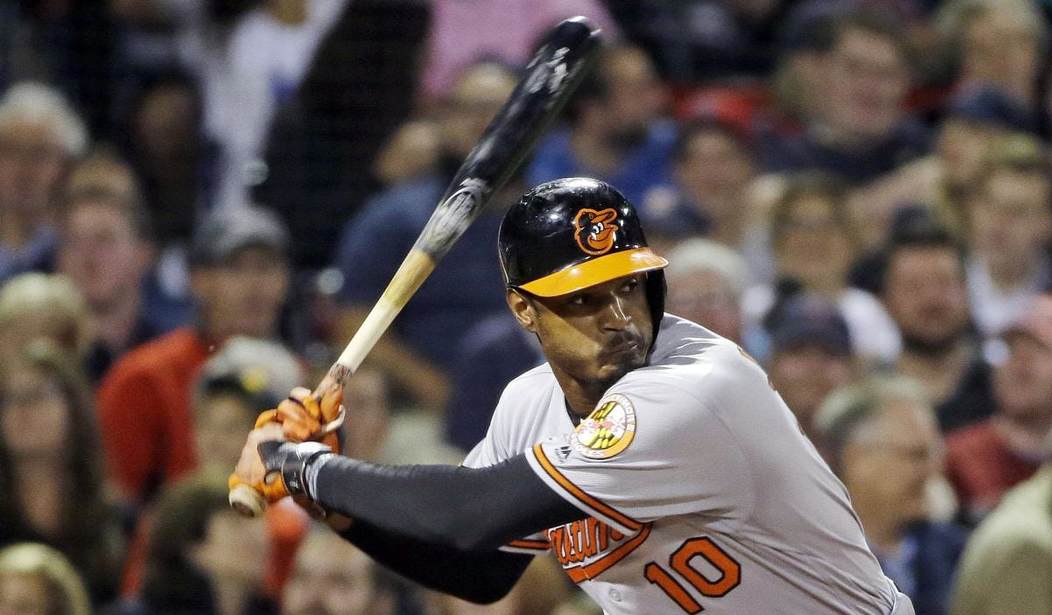Adam Jones, star outfielder for the Baltimore Orioles baseball team, was asked by USA Today why, unlike in the NFL, there have been no national anthem protests by black athletes in Major League Baseball.
“We already have two strikes against us already,’’ Baltimore Orioles All-Star center fielder Adam Jones told USA TODAY Sports, “so you might as well not kick yourself out of the game. In football, you can’t kick them out. You need those players. In baseball, they don’t need us.
“Baseball is a white man’s sport.’’
ESPN senior writer Howard Bryant took that notion a step further and wrote that baseball is “designed” that way.
If the current pattern of behavior toward the truth applies, Jones will suffer the type of misdirection and distortion that Kaepernick has experienced. The substance of his words will be mauled, chewed and twisted beyond recognition, in ways like how tennis players John Isner and Ryan Harrison, neither of whom had uttered a single word of knowledge about the history of police-community relations, of African-American history in baseball or otherwise, now feel emboldened to talk while saying nothing, to pander to the public about just how dedicated they are to patriotism, whatever that means. Jones will have to listen to the wounded protestations from baseball executives, colleagues and writers who, faced with the impossible task of refuting him, will instead simply express “disappointment” or “outrage” at his comments. In this case, patriotism, disappointment or outrage should mean knowing what one is talking about.
Instead, the baseball industry has essentially confirmed Jones’ suspicions through a deafening silence of incuriosity that further severs it from its groundbreaking past, and the truth of the matter is sinking into the soil: Baseball is a white man’s game, and is so by the specific design of the people who run it. In a country full of world-class black athletes, baseball cannot seem to attract many. Nothing Jones said is statistically, factually or anecdotally remarkable except for that he took the remarkable step of actually saying it.
Bryant obviously doesn’t follow baseball or he would know that the lack of black players in the game has been a topic of discussion for the last decade.
I guess just because ESPN hasn’t produced a “30 for 30” documentary on the subject, Bryant doesn’t think it’s been an issue of intense discussion among baseball elites.
And can we please lose the narrative that Colin Kaepernick and other anthem protesters are being persecuted? Kaepernick’s jersey sales are through the roof; he has been praised from coast to coast in every major media outlet, the president has approved of his protest; and the league, his team, and his teammates have all come out in support of him.
But Kaepernick et. al. don’t want “respect” as Adam Jones suggested. They demand you agree with them and if you don’t you’re persecuting them.
But Jones makes one valid point: the number of black players has declined precipitously to the point that MLB is pouring millions of dollars into turning young black kids on to the game.
On opening Day 2016, only 8% of roster players were black, with 30% Hispanic. That’s down from almost 20% black players in 1995. The NFL is made up of 68% black players while the NBA has 74%.
So the question isn’t whether Jones is being wrong about player participation. Going further, the demographics of who watches the games is also heavily tilted toward older white males. Where Jones and Bryant get it wrong is on the question of why there aren’t more black players in the game. Is baseball really “designed” as a white man’s game?
Professional sports is one of the last meritocracies on the planet. And baseball, while simple on the surface, has an extraordinary amount of nuance in the professional game for any prospect to learn. Talent will only get you so far. The history of baseball is littered with pitchers who could throw 95 MPH and hitters who could club the ball 500 feet never even getting a sniff of the Big Leagues. The 162-game season (compared to 35 high school games and 60 college games) is a major challenge.
Rare is the baseball prospect who goes directly from high school to the pros — at one time a somewhat common occurrence in the NBA. It’s the norm for college football players to go straight from school into the professional ranks. But while NBA and NFL players are multi-millionaires by age 23, most baseball prospects are still stuck in the minor leagues at that age, toiling away for relatively small salaries.
A star black athlete in high school who may have played football, basketball, and baseball might be offered a choice of going to college for a year or two on a football or basketball scholarship and then going pro, or spending five years in the baseball minor leagues. It’s a no-brainer for most kids.
Professional sports is a brutal profession for people of any color. Teams will milk your talent to the last possible drop. And then, when age kills your skills or you lose confidence and your game goes south, they throw you out with the trash and turn their attention to the next eager young athlete who harbors dreams of glory. This holds true for players of any race.
There are fewer blacks in Major League Baseball not because the games is “designed” to keep them out, but because opportunities for gifted black athletes to play other sports are more attractive. In the end, it’s money not racism that has been the cause of the decline in black participation at the major league level.










Join the conversation as a VIP Member